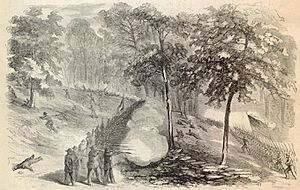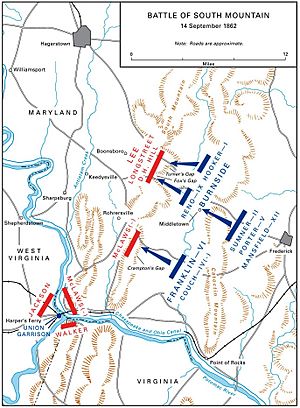Battle of South Mountain facts for kids

The Battle of South Mountain happened on September 14, 1862, in Maryland. It was fought between the Confederate and Union armies. This battle was very important. It was the first major battle fought north of the Potomac River. It was also the first time the Confederate army invaded the Northern United States. Here, General Robert E. Lee and his Confederate soldiers were stopped and turned back. This long battle was fought to control three mountain passes: Crampton's, Turner's, and Fox's Gaps.
Why the Battle Happened
By the summer of 1862, the Union's hope of quickly ending the Civil War was fading. In July, Major General George B. McClellan failed to capture the Southern capital at Richmond, Virginia. Then, in late August, the Union lost another battle at the Second Battle of Bull Run.
Soon after, General Lee decided to invade the North. He led his Army of Northern Virginia into Maryland on September 4, 1862. Lee believed that if the war moved into Union states, a big victory might convince Great Britain and France to help the South. He also hoped it would make the North want to end the war. This would help the Confederate States of America become an independent country.
McClellan remained in charge of the Army of the Potomac. When Lee entered Maryland, McClellan moved faster than usual to stop him. A Union soldier found a copy of Lee's secret plan, called Special Order 191. This plan showed that Lee had split his army. McClellan learned that General Stonewall Jackson was sent to attack Harpers Ferry Armory. This information gave McClellan a chance to defeat Lee's army while it was divided.
McClellan found Lee's plan on September 13. He was very excited, saying he could now defeat Lee. He also told President Abraham Lincoln that he had the rebels' plans and would catch them. But McClellan waited 18 more hours before acting. This delay gave Lee more time to bring his army back together. As Lee moved into Maryland, he left small groups of soldiers to guard two important passes through South Mountain: Crampton's Gap and Turner's Gap. If McClellan had moved faster, he might have caught Lee's army spread out on the other side of the mountain.
The Battle Itself
On September 14, the battle took place at the three gaps. A few Confederate regiments guarded Turner's and Fox's Gaps in the north, and Crampton's Gap in the south. The Union army attacked from the east in two waves. The first attack was at Fox's Gap around 9 AM. In the early afternoon, the second wave hit both Fox's and Turner's Gaps at the same time. Crampton's Gap was attacked later in the afternoon.
The distance between Crampton's and Turner's Gaps is about six miles. The land between them made each part of the battle a separate fight. Fighting continued all day at Turner's Gap and all afternoon at Crampton's Gap. The battle at Turner's Gap was bigger, cost more lives, and lasted longer. The Confederate soldiers used this to trick the Union forces. The Union thought many Confederates were on the mountain. But only one Confederate division guarded the passes until later in the afternoon. The Union forces could have easily pushed them aside if they had known how few soldiers were there.
McClellan focused his attack on South Mountain. This meant he did not help the Union soldiers at Harpers Ferry. McClellan knew Jackson was attacking Harpers Ferry from Lee's secret order. The little help he sent arrived too late to stop the surrender. This also gave Lee the time he needed to gather his forces at Sharpsburg, Maryland. If McClellan had moved faster, the costly Battle of Antietam might not have happened.
The Confederates lost about 2,700 soldiers. The Union lost 2,300 soldiers who were killed or wounded. The Confederates bravely defended the gaps, which delayed McClellan's forces. This gave Lee valuable time to regroup and move to Sharpsburg. There, the Battle of Antietam would happen. The Battle of South Mountain forced Lee to give up his plans for invading the North. It made him have to defend his army instead.
Battlefield Preservation
The Civil War Trust (now part of the American Battlefield Trust) and its partners have saved 647 acres of the South Mountain battlefield.
Images for kids




